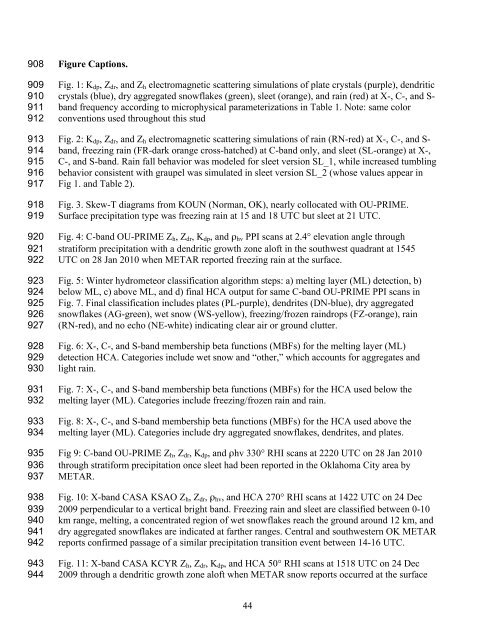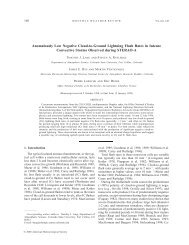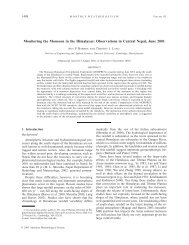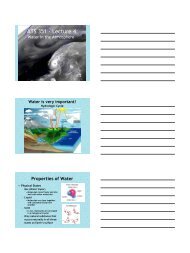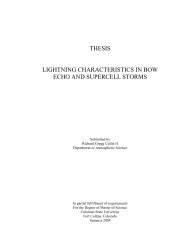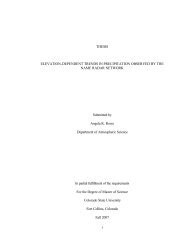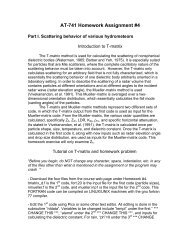1 A dual-polarization radar hydrometeor classification algorithm for ...
1 A dual-polarization radar hydrometeor classification algorithm for ...
1 A dual-polarization radar hydrometeor classification algorithm for ...
You also want an ePaper? Increase the reach of your titles
YUMPU automatically turns print PDFs into web optimized ePapers that Google loves.
908909910911912913914915916917918919920921922923924925926927928929930931932933934935936937938939940941942943944Figure Captions.Fig. 1: K dp , Z dr , and Z h electromagnetic scattering simulations of plate crystals (purple), dendriticcrystals (blue), dry aggregated snowflakes (green), sleet (orange), and rain (red) at X-, C-, and S-band frequency according to microphysical parameterizations in Table 1. Note: same colorconventions used throughout this studFig. 2: K dp , Z dr , and Z h electromagnetic scattering simulations of rain (RN-red) at X-, C-, and S-band, freezing rain (FR-dark orange cross-hatched) at C-band only, and sleet (SL-orange) at X-,C-, and S-band. Rain fall behavior was modeled <strong>for</strong> sleet version SL_1, while increased tumblingbehavior consistent with graupel was simulated in sleet version SL_2 (whose values appear inFig 1. and Table 2).Fig. 3. Skew-T diagrams from KOUN (Norman, OK), nearly collocated with OU-PRIME.Surface precipitation type was freezing rain at 15 and 18 UTC but sleet at 21 UTC.Fig. 4: C-band OU-PRIME Z h , Z dr , K dp , and ! hv PPI scans at 2.4° elevation angle throughstrati<strong>for</strong>m precipitation with a dendritic growth zone aloft in the southwest quadrant at 1545UTC on 28 Jan 2010 when METAR reported freezing rain at the surface.Fig. 5: Winter <strong>hydrometeor</strong> <strong>classification</strong> <strong>algorithm</strong> steps: a) melting layer (ML) detection, b)below ML, c) above ML, and d) final HCA output <strong>for</strong> same C-band OU-PRIME PPI scans inFig. 7. Final <strong>classification</strong> includes plates (PL-purple), dendrites (DN-blue), dry aggregatedsnowflakes (AG-green), wet snow (WS-yellow), freezing/frozen raindrops (FZ-orange), rain(RN-red), and no echo (NE-white) indicating clear air or ground clutter.Fig. 6: X-, C-, and S-band membership beta functions (MBFs) <strong>for</strong> the melting layer (ML)detection HCA. Categories include wet snow and “other,” which accounts <strong>for</strong> aggregates andlight rain.Fig. 7: X-, C-, and S-band membership beta functions (MBFs) <strong>for</strong> the HCA used below themelting layer (ML). Categories include freezing/frozen rain and rain.Fig. 8: X-, C-, and S-band membership beta functions (MBFs) <strong>for</strong> the HCA used above themelting layer (ML). Categories include dry aggregated snowflakes, dendrites, and plates.Fig 9: C-band OU-PRIME Z h , Z dr , K dp , and !hv 330° RHI scans at 2220 UTC on 28 Jan 2010through strati<strong>for</strong>m precipitation once sleet had been reported in the Oklahoma City area byMETAR.Fig. 10: X-band CASA KSAO Z h , Z dr , ! hv , and HCA 270° RHI scans at 1422 UTC on 24 Dec2009 perpendicular to a vertical bright band. Freezing rain and sleet are classified between 0-10km range, melting, a concentrated region of wet snowflakes reach the ground around 12 km, anddry aggregated snowflakes are indicated at farther ranges. Central and southwestern OK METARreports confirmed passage of a similar precipitation transition event between 14-16 UTC.Fig. 11: X-band CASA KCYR Z h , Z dr , K dp , and HCA 50° RHI scans at 1518 UTC on 24 Dec2009 through a dendritic growth zone aloft when METAR snow reports occurred at the surface44


